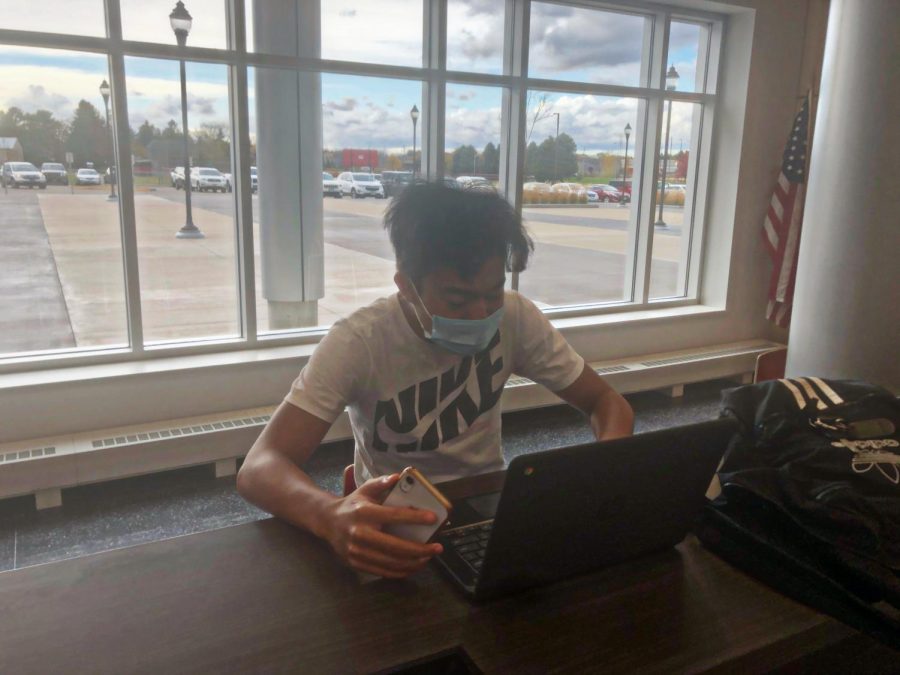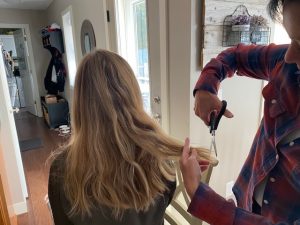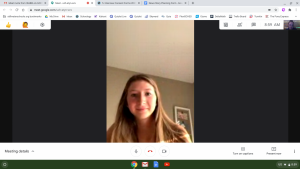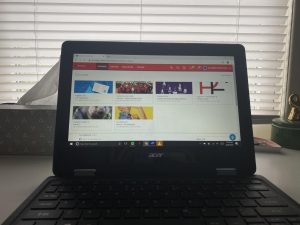Covid 19 forces Online learning making students and teachers reliance more on technology.
Junior Alwyn Malinis works on history notes on his computer while reading the online textbook on his phone. Due to online learning, it is not uncommon for students to have to use multiple devices to complete their work.
October 31, 2020
Since the start of the 2020 school year, students and teachers have relied heavily on technology to complete work as a result of the e-learning system put in place to combat the spread of COVID-19.
Ever since the online learning model was introduced, many teachers have replaced traditional paper assignments with work that is completed and submitted online. This allows students who are at home to complete work at the same pace as their peers who are physically in school. Because of this, a majority of the school day, for teachers and students, is spent using technology.
“I think that online students especially are spending too much time in front of their screens. I think it was a problem before COVID and before online learning, students spending way too much time on the computer or watching TV,” AP world history teacher Mitchell Weege said. “Usually school would be a time where students are not completely consumed by their devices, but now they have them out almost the entire school day. It definitely is concerning, considering that many students are now spending more time every day in front of a screen than away from one.”
One reason that the school has transitioned to primarily online work is to limit the contact between students and teachers. With e-learning, work is able to be completed, turned in, and graded with making little to no contact. Keeping these precautions in mind, it has been shown that COVID-19 is actually very unlikely to spread on surfaces such as paper.
Weege believes it is still important to do everything we can to limit the chances of spreading COVID, regardless of little it helps.
“As of right now, just to minimize contact such as teachers giving students papers or students passing work to each other, it is best to have as little work on paper as possible,” Weege said. “Even if it is unlikely that passing paper would spread COVID, we still want to be taking every precaution that we possibly can.”
Because students in the hybrid model of school are only at school a fraction of the time that they typically would, and online students are never actually on the school campus, they have much less social interaction with each other along with the teachers. With there being so little interaction between them, it becomes much more difficult to get to know each other.
“It is hard to build a relationship behind a screen, and it is hard to build a relationship behind a mask” Science and Astronomy teacher Ben Straka said. “From my observations, students are also having a hard time building relationships with each other. Not only from a teacher to student standpoint, but also from a student to student standpoint, there is much less interaction,” Straka said.
One method that some teachers are using allows students to spend less time on their devices, while still getting their work done. As simple as it sounds, the solution involves giving students paperwork, and having them turn in a picture of it when it is done. This allows teachers and students to complete and grade homework online, without having to send time completing it in front of a screen.
Straka says that it is important to keep students writing with a pencil rather than typing out their work. He believes this will allow students to stay engaged and continue to make connections that cause them to think at high levels. He also explained that he made some changes to keep students using pencil and paper as much as possible, like removing partially completed note packets, and having his class take their notes completely from scratch.
Students are taking three classes each quarter, but they have to go through a full semester’s worth of work in that time period. This can make it more difficult for students to retain information as it is being gone through so fast, and it does not help that many students need to receive help over video calls or emails rather than in person.
“It has been much harder to remember everything I am learning this year. All of my classes are going through material so fast, it gets really hard to keep up, especially if I don’t understand something,” junior Alwyn Malinis explained. “If I have a question I either have to wait until the next day I go to school to ask one of my teachers, or I have to email them, and it is almost impossible to explain a class such as math over email.”
The new online learning model introduced for the 2020-2021 school year has helped maintain safety for students and staff of the high school, but there are still many problems that come with it. The limited social interaction is taking a toll on students, and it has been hard for many of them to stay motivated when they are spending hours in front of their computers at school. All of this has been very new to both teachers and students, but they are still finding solutions to make this year go as smoothly as possible.
“From my observations, students are also having a hard time building relationships with each other. Not only from a teacher to student standpoint, but also from a student to student standpoint, there is much less interaction,” Straka said.













